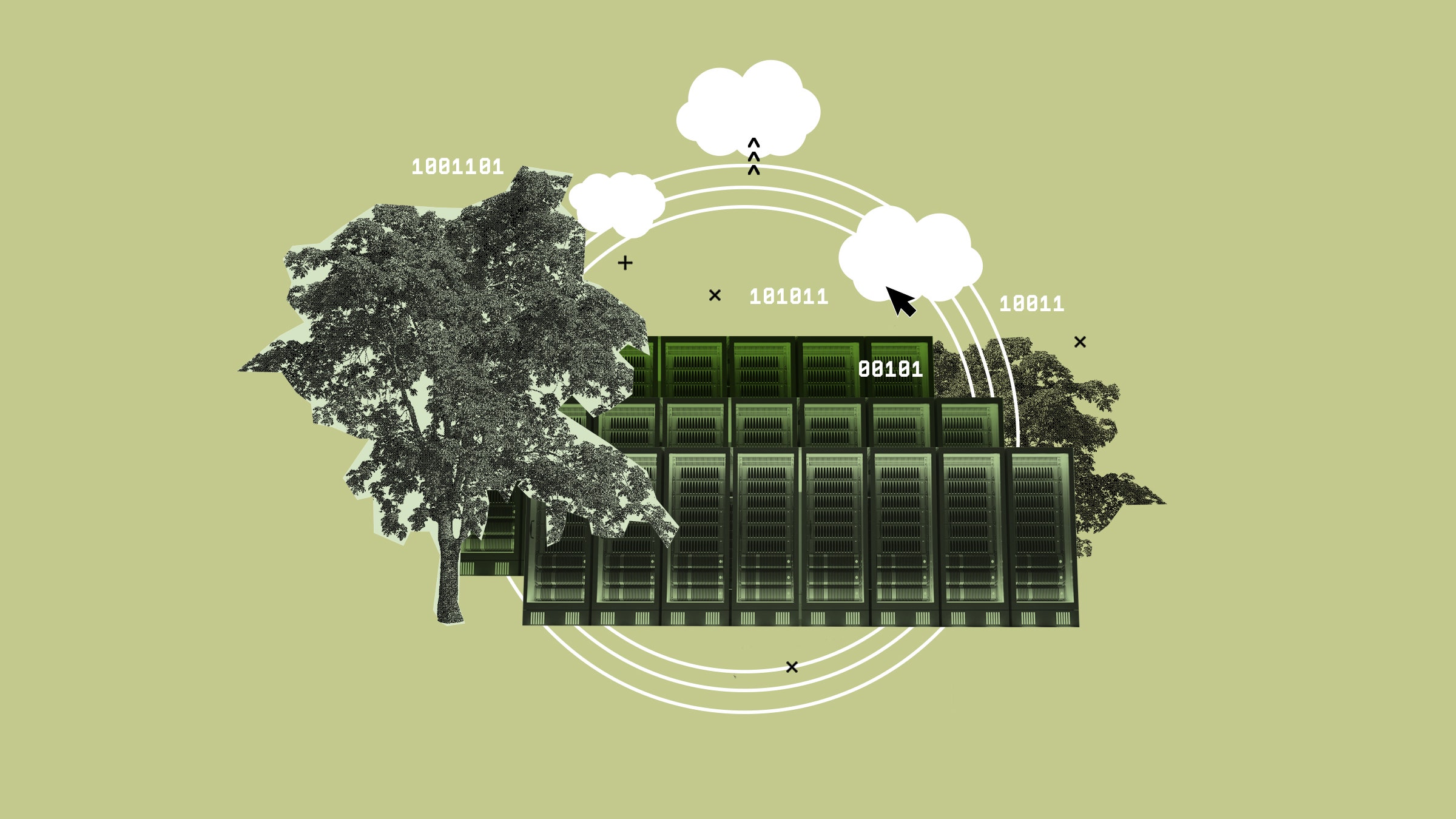DATA IS THE new oil” may have outlasted its usefulness as a metaphor, but one aspect still rings true: Both industries have a serious environmental footprint. According to the Department of Energy, data centers account for about 2 percent of all electricity use in the US.
That means the cloud—which powers every Netflix binge, PUBG match, and email—has a lining made not of silver, but of carbon. For individuals, the bits in question don’t amount to much. The digital footprints of businesses, however, can be large enough to ding the environment. For them, finding the greenest way to store their data would help cut down on their emissions. But how does a high-minded plutocrat go about that? The answers are not always obvious.
The top three cloud providers—Amazon Web Services, Google Cloud, and Microsoft Azure—account for approximately two-thirds of all rentable computing services, so WIRED has compiled a guide to help you understand how they decarbonize your data.
What Makes a Cloud Green?
Some companies still store their data in blinking black boxes in a hallway closet. Others have such massive computing needs that they’ve built their own data centers. For everyone in between, there are basically three options: pay either Amazon, Microsoft, or Google for the privilege of stuffing your data into one of their mind-boggingly large “hyperscale” server farms.
To assess the relative greenness of different clouds, Jonathan Koomey, an expert on the topic, highlights three metrics: The efficiency of a data center’s infrastructure (lights, cooling, and so on), the efficiency of its servers, and the source of its electricity.
Each of the Big Three cloud providers has ironed out inefficiencies in the hardware and software running in their data centers. They run virtual machines on their servers to limit downtime, install custom cooling systems, automate wherever possible, and so on. This ruthless pursuit of efficiency has helped the data center industry keep its energy needs fairly constant over the past decade. It also means that when companies move their data from in-house servers to the cloud, they will almost certainly end up reducing their energy consumption.
It won’t stay that way forever, warns Dale Sartor, a staff scientist at the Lawrence Berkeley National Laboratory who studies energy efficiency. Someday we’ll hit a tipping point, when most organizations have already moved their data centers offsite. Then the energy demands of the cloud will start to rise. “I don’t think anybody envisions a reduction in the growth of our appetite for computation,” Sartor says. “So the chances we’re going to see an explosion in energy use sometime in the next couple of decades is pretty high.”
That’s why a critical measure of a data center’s greenness is the source of its energy. The Big Three have all pledged to completely decarbonize their data centers, but none has entirely ditched fossil fuels yet.
To clean up their carbon footprints, these companies lean heavily on a tool known as a renewable energy credit, which is basically a token representing a utility’s green energy generation. RECs are how companies like Google and Microsoft can claim their data centers are powered 100 percent by renewables while still being connected to grids that use fossil fuels. In reality, only a fraction of each company’s energy comes directly from solar or wind installations; the rest comes from RECs.
Calculating the greenness of a cloud is rife with nuanced distinctions. In the report card below, we’ve highlighted some of the most important factors to consider if you’re looking to decarbonize your data.
Google Cloud
What they say:
Of the Big Three, Google has the smallest share of the market, but it has arguably done the most to decarbonize its data. In 2017, the company announced it achieved 100 percent renewable energy across all of its operations, including its data centers. It claims that all data processed by Google Cloud has “zero net carbon emissions.”
How they do it:
Google says it is the “largest corporate buyer of renewable energy in the world,” and in September it increased its renewable energy portfolio by 40 percent through power purchase agreements with utilities around the world. These types of deals are designed to fund the construction of new renewable energy projects in exchange for access to their energy once they’re online. The idea, which Google helped pioneer, is to expand renewable resources on the grid.
In addition to renewable energy plays, Google uses machine learning to continuously optimize its data centers. An algorithm trained on historical weather data, for example, knows how to tweak a data center’s cooling system in response to the environment, says Joe Kava, Google’s vice president of data centers. The system samples various weather conditions every 5 minutes so if there’s a sudden drop in temperature, the facility knows to devote less energy to cooling the servers.
What’s the catch?
In 2018, Google started an oil and gas division with the explicit aim of attracting the fossil fuel industry. The company promised that its machine-learning tools combined with its cloud service could help those companies better act on their data—in other words, helping them extract oil and gas from existing reserves faster and more efficiently.
It’s also worth noting that in parts of the world with little to no renewable energy installations, Google’s data centers still rely on fossil fuels. To atone, the company purchases RECs.
What to expect:
Google Cloud does its carbon accounting on an annual, global basis. At the end of a year, the company tallies up its energy use and renewable energy purchases and makes sure they’re equal. Kava says Google wants its data centers to be powered by 100 percent renewable electricity on an hourly basis. This is a lot more ambitious—the sun isn’t always shining, the wind isn’t always blowing, but the internet firehose never shuts off. That will require not only more renewable installations, but a lot of new technologies, such as long-term energy storage.
Making better use of what renewables do exist will help stretch them farther. Earlier this year, the data center team partnered with Google’s AI unit, DeepMind, to make a machine-learning model to predict wind farm output up to 36 hours in advance. Utilities could use this information to better plan around wind variability and, as a result, increase the amount of wind energy available on the grid.
- Overall Greenness: B+
- Energy Efficiency: A+
- Transparency: A
- Technological Innovation: A
- Total Renewable Energy Portfolio: 5.5 GW
Microsoft Azure
What they say:
Microsoft’s self-proclaimed goal is to “make the data center disappear” by totally eliminating the environmental impact of its server farms. The company has been carbon neutral since 2012, and including its RECs, it has run on 100 percent renewable energy since 2014. Without RECs, Microsoft’s data centers run on 60 percent renewable electricity and the company plans to boost this to 70 percent renewable energy by 2023.
How they do it:
Microsoft has implemented some unique company policies, including internal carbon taxes that push departments, including the Azure team, to minimize their climate impact.
The company is also making big investments in clean energy projects. Earlier this year, it entered a five-year hydro power purchase agreement in Washington and began negotiations to purchase power from a new wind farm in the state. Around the same time, Microsoft closed a deal for a 74-megawatt solar project in North Carolina. This brings Microsoft’s total renewable energy portfolio to around 1.9 gigawatts, says Brian Janous, general manager of energy and sustainability. This is a roughly 60 percent increase over the past year.
Microsoft has also been investing in research meant to increase the energy efficiency of its existing and future data centers. Last year, the company began experimenting with data centers on the ocean floor, which could lower or eliminate cooling and other energy costs. Microsoft has also been exploring fuel cells as a means to power its data centers. Like Google, Microsoft uses machine learning to improve the efficiency of its data center infrastructure. It also runs a grant program that provides cloud computing credits for researchers working on climate-related issues.
What’s the catch?
Microsoft is also courting the fossil fuel industry. In September, the company announced a partnership with the oil and gas giants Chevron and Schlumberger to “accelerate creation of innovative petrotechnical and digital technologies,” using the Azure platform. The partnership elicited anger from a coalition of Microsoft employees who accused the company of “complicity in the climate crisis.” Many Microsoft employees participated in a walkout pegged to the global climate strike a few days after the announcement.
Although Microsoft’s data centers have been 100 percent renewable since 2014, they still use fossil fuels. The company offsets its fossil fuel use with RECs.
One other consideration: Microsoft is exploring the use of natural gas to power its data centers. While natural gas does offer some energy efficiency improvements, it is not a renewable resource and contributes to the company’s carbon footprint.
Janous points to fuel cells as a way to turn a data center into its own power plant by directly generating electricity on site. The hope is that one day hydrogen will become abundant and cheap, allowing for the integration of low-carbon fuel cells. (Right now the company is doing its testing with natural gas.)
Microsoft is also investing heavily in developing battery technology for its data centers. Whether using batteries or fuel cells, turning data centers into large energy storage sites could make better use of renewable energy by capturing it when it flows freely on sunny or windy days, and tapping into these stores when it’s less abundant. Last year, Microsoft started a pilot project with a data center in Virginia using on-site batteries.
- Overall Greenness: B
- Energy Efficiency: A
- Transparency: A
- Technological Innovation: A+
- Total Renewable Energy Portfolio: 1.9 GW
Amazon Web Services
What they say:
Amazon Web Services is by far the biggest cloud computing provider, with well over one-third of the market. In 2014, CEO Jeff Bezos announced a long-term commitment to power all of Amazon’s data centers with 100 percent renewable energy. It has since constructed several wind and solar farms. Earlier this year, Bezos promised to achieve net zero carbon emissions by 2040 after facing significant pressure from employees and investors. In 2018, Amazon announced it had achieved 50 percent renewable energy usage across the company when RECs are factored in.
To date, Amazon has entered power purchase agreements that have produced three new wind farms and six solar farms in the US and with several more under construction. Like the other providers, AWS offsets its carbon emissions with RECs.
Earlier this year, a Greenpeace report accused Amazon of abandoning its commitment to 100 percent renewable energy. As the report noted, some of its largest data centers are powered by only 12 percent renewable energy. In Virginia, which supports the core of Amazon’s cloud infrastructure, AWS increased its operations by 59 percent in the last two years without adding any new renewable energy, according to the Greenpeace report. Amazon responded to the report by saying it is still committed to 100 percent renewable energy.
Amazon has also made a habit of keeping information about its carbon footprint out of public view. Although it released its global carbon footprint for the first time this year, it petitioned the Australian government to withhold this data from an annual report on carbon emissions in the country. Amazon has also been criticized for not providing a clear road map for how the company will reach its 100 percent renewable energy goal.
Finally, AWS too is touting its services to the oil and gas industry. Its website sells its cloud service as a way to “accelerate and optimize exploration, drilling, and production.”
Amazon did not respond to multiple requests for comment on either the present or the future of AWS.
- Overall Greenness: C-
- Energy Efficiency: B
- Transparency: F
- Technological Innovation: Unknown
- Total Renewable Energy Portfolio: 1.6 GW




